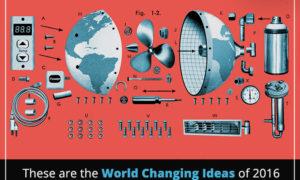To propel to a bright future the pursuit of 21st century skills: collaborative problem-solving, IT, information and economic literacy, require innovative thinking and strategic vision. Today, innovation has become a standard practice in the world of technology, business and education. It has become a common buzzword in our society: young people increasingly favoring innovative solutions over conventional problem solving methods.
Some ideas really do bend the curve of human history. However, it’s too advanced to predict whether quantum computers, carbon batteries, ingestible robots and some other, relatively newer, ideas mentioned in the article will have a similar impact on the world. An innovative idea is always exposed to challenging circumstances where the risk of failure is high. However, it is a fact that some ideas fail and drop from the race. On the other hand, those with a positive impact throughout the industry face better odds of success and do fairly well; and a few of those, of course, go on to change the face of human civilization.
Batteries Could Pull Carbon From the Atmosphere
Electrochemical cells could use carbon in the atmosphere and convert it into electricity
We cannot stop global warming at this point in time just by cutting greenhouse gas emissions from burning fossil fuels. However, we can remove some of the carbon dioxide that already exists in the atmosphere. There are many ways to help reduce carbon dioxide in the air. But, those techniques generally consume substantial amount of energy.
How to Make An Antibiotic From Scratch
A useful method of designing antibiotic drugs could help kill drug-resistant bacteria
Antibiotics have become part of our lives and it’s hard to think of a world without antibiotics and antiseptic drugs.
It has been reported by the American Centers for Disease Control and Prevention that in the United States alone an average of 23,000 people lost their lives daily from infectious disorders that antibiotics can no longer treat.
By the year 2050, antibiotic resistance will result in 10 million deaths worldwide each year, according to a study, conducted by the U.K government.
Betting big on new forms of antibiotics, deemed as the future of medication, scientists have tried to develop new drugs that can treat more genotypes of the virus and bacteria.
Quantum Satellites Would be a Big Step Towards the New Unhackable Internet
Space-based flow of quantum data could be the First Step to mankind reaching new heights. The research on quantum computing could open a way to the most useful application of Quantum Satellites: the “unhackable” Internet.
An efficient and secure cryptography requires no advanced technology, all we need is a pencil and paper: Make a unique combination of letters and digits to serve as the key for an encrypted message.
Write the combination down on a piece of paper, use it once, and never again. The cryptography technique is to make sure nobody intercepts or interferes with the encrypted message.
Ingestible Robots are designed to perform Surgery from within the body
Ingestible Robot is considered as a tool for one of the most promising medical treatments. A Remote-controlled ingestible robot is programmed to work inside the human body.
Machine-Learning Computer Program Reads Satellite Images to Detect Poor Areas
Conducting an economic survey in poor and war-torn regions can be highly dangerous and totally expensive way.
Researchers have tried to work around this by offering a solution that is searching nighttime satellite images for mostly dark regions where electricity doesn’t reach. This trick will allow them to precisely locate poverty-stricken areas.
A Nanoporous Fabric Made From Battery Material Reducing the Need for Air-Conditioning
The hotter the earth gets, the more people will be exposed to severe weather changes and the use of air conditioner will start to grow. But air conditioning consumes huge amounts of energy, meanwhile, generating massive greenhouse gas emissions. The newly created Nanoporous fabric is designed to cool off the body in severe weather conditions.
Computers are Better at Recognizing Shapes and Patterns Than Humans
If somebody shows you an unfamiliar pattern or character and asked you to write it down on a paper, you could most likely accomplish the goal.
A machine, however, is unable to accomplish the given task —even if it were equipped with complicated algorithms and advanced features like deep-learning and artificial intelligence. The machine-learning system requires huge amount of data instructions for each and every move. However, the computer scientists, have figured out a way to implement artificial intelligence in order to solve problems quickly. They have found an approach to deep-learning that has enabled the computers to recognize random shapes and patterns faster than humans are able to do.
Reference: The Scientific American
image: fastcoexist.com


